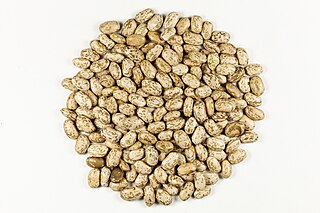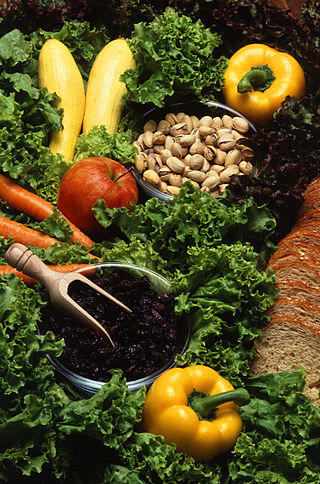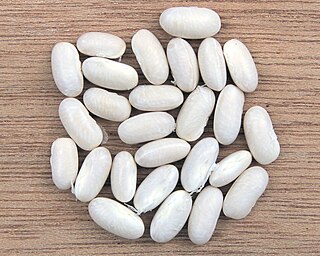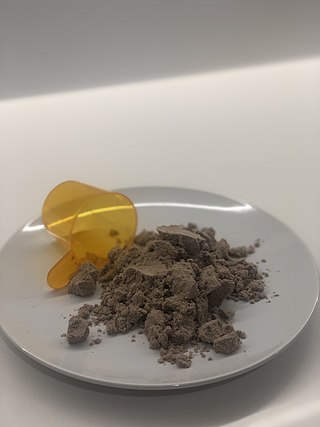Related Research Articles

A bean is the seed of several plants in the family Fabaceae, which are used as vegetables for human or animal food. They can be cooked in many different ways, including boiling, frying, and baking, and are used in many traditional dishes throughout the world.

The chickpea or chick pea is an annual legume of the family Fabaceae, subfamily Faboideae. Its different types are variously known as gram or Bengal gram, chhola, chhana, chana, or channa, garbanzo or garbanzo bean, or Egyptian pea. Chickpea seeds are high in protein. It is one of the earliest cultivated legumes, the oldest archaeological evidence of which was found in Syria.

The pinto bean is a variety of common bean. In Spanish they are called frijoles pintos. It is the most popular bean by crop production in Northern Mexico and the Southwestern United States, and is most often eaten whole, or mashed and then refried. Either way, it is a common filling for burritos, tostadas, or tacos in Mexican cuisine, also as a side or as part of an entrée served with a side tortilla or sopaipilla in New Mexican cuisine.

Legumes are plants in the family Fabaceae, or the fruit or seeds of such plants. When used as a dry grain for human consumption, the seeds are also called pulses. Legumes are grown agriculturally, primarily for human consumption; for livestock forage and silage; and as soil-enhancing green manure. Well-known legumes include beans, soybeans, chickpeas, peanuts, lentils, lupins, grass peas, mesquite, carob, tamarind, alfalfa, and clover. Legumes produce a botanically unique type of fruit – a simple dry fruit that develops from a simple carpel and usually dehisces on two sides.

Phaseolus acutifolius, also known as the tepary bean, is a legume native to the southwestern United States and Mexico and has been grown there by the native peoples since pre-Columbian times. It is more drought-resistant than the common bean and is grown in desert and semi-desert conditions from Arizona through Mexico to Costa Rica. The water requirements are low. The crop will grow in areas where annual rainfall is less than 400 mm (16 in).

A lima bean, also commonly known as butter bean, sieva bean, double bean or Madagascar bean, is a legume grown for its edible seeds or beans.

Phaseolus vulgaris, the common bean, is a herbaceous annual plant grown worldwide for its edible dry seeds or green, unripe pods. Its leaf is also occasionally used as a vegetable and the straw as fodder. Its botanical classification, along with other Phaseolus species, is as a member of the legume family Fabaceae. Like most members of this family, common beans acquire the nitrogen they require through an association with rhizobia, which are nitrogen-fixing bacteria.

Vegetarian nutrition is the set of health-related challenges and advantages of vegetarian diets.

Lablab purpureus is a species of bean in the family Fabaceae. It is native to sub-Saharan Africa and India and it is cultivated throughout the tropics for food. English language common names include hyacinth bean, lablab-beanbonavist bean/pea, dolichos bean, seim or sem bean, lablab bean, Egyptian kidney bean, Indian bean, bataw and Australian pea. Lablab is a monotypic genus.

Green beans are young, unripe fruits of various cultivars of the common bean, although immature or young pods of the runner bean, yardlong bean, and hyacinth bean are used in a similar way. Green beans are known by many common names, including French beans, string beans, and snap beans or simply "snaps." In the Philippines, they are also known as "Baguio beans" or "habichuelas" to distinguish them from yardlong beans.

The black turtle bean is a small, shiny variety of the common bean especially popular in Latin American cuisine, though it can also be found in the Cajun and Creole cuisines of south Louisiana. Like all varieties of the common bean, it is native to the Americas, but has been introduced around the world. It is also used in Indian cuisine, Tamil cuisine, where it is known as karuppu kaaramani and in Maharashtrian cuisine, where it is known as Kala Ghevada. It is widely used in Uttrakhand India also known as "Bhatt". It is a rich source of iron and protein. The black turtle bean is often simply called the black bean, although this terminology can cause confusion with at least three other types of black beans.

Cyclanthera pedata, known as caigua, is a herbaceous vine grown for its edible fruit, which is predominantly used as a vegetable. It is known from cultivation only, and its use goes back many centuries as evidenced by ancient phytomorphic ceramics from Peru depicting the fruits.
Isoflavones are substituted derivatives of isoflavone, a type of naturally occurring isoflavonoids, many of which act as phytoestrogens in mammals. Isoflavones are produced almost exclusively by the members of the bean family, Fabaceae (Leguminosae).

The navy bean, haricot bean, pearl haricot bean, Boston bean, white pea bean, or pea bean is a variety of the common bean native to the Americas, where it was first domesticated. It is a dry white bean that is smaller than many other types of white beans, and has an oval, slightly flattened shape. It features in such dishes as baked beans, various soups such as Senate bean soup, and even pies.

α-Amylase is an enzyme that hydrolyses α bonds of large, α-linked polysaccharides, such as starch and glycogen, yielding shorter chains thereof, dextrins, and maltose, through the following biochemical process:

Antinutrients are natural or synthetic compounds that interfere with the absorption of nutrients. Nutrition studies focus on antinutrients commonly found in food sources and beverages. Antinutrients may take the form of drugs, chemicals that naturally occur in food sources, proteins, or overconsumption of nutrients themselves. Antinutrients may act by binding to vitamins and minerals, preventing their uptake, or inhibiting enzymes.

Pea protein is a food product and protein supplement derived and extracted from yellow and green split peas, Pisum sativum. It can be used as a dietary supplement to increase an individual's protein or other nutrient intake, or as a substitute for other food products. As a powder, it is used as an ingredient in food manufacturing, such as a thickener, foaming agent, or an emulsifier.
The Appaloosa bean is a cultivar bean variety of the species Phaseolus vulgaris.
Protein quality is the digestibility and quantity of essential amino acids for providing the proteins in correct ratios for human consumption. There are various methods that rank the quality of different types of protein, some of which are outdated and no longer in use, or not considered as useful as they once were thought to be. The Protein Digestibility Corrected Amino Acid Score (PDCAAS), which was recommended by the Food and Agriculture Organization of the United Nations (FAO), became the industry standard in 1993. FAO has recently recommended the newer Digestible Indispensable Amino Acid Score (DIAAS) to supersede PDCAAS.
Digestible Indispensable Amino Acid Score (DIAAS) is a protein quality method proposed in March 2013 by the Food and Agriculture Organization to replace the current protein ranking standard, the Protein Digestibility Corrected Amino Acid Score (PDCAAS).
References
- ↑ Zheng Z, Sumi K, Tanaka K, Murai N (November 1995). "The Bean Seed Storage Protein [beta]-Phaseolin Is Synthesized, Processed, and Accumulated in the Vacuolar Type-II Protein Bodies of Transgenic Rice Endosperm". Plant Physiology. 109 (3): 777–786. doi:10.1104/pp.109.3.777. JSTOR 4276867. PMC 161377 . PMID 12228632.
- ↑ Blagrove RJ, Colman PM, Lilley GG, Van Donkelaar A, Suzuki E (1983). "Physicochemical and structural studies of phaseolin from French bean seed". Plant Foods for Human Nutrition. 33 (2–3): 227–9. doi:10.1007/BF01091313.
- ↑ Osborne TB (1894). "The Proteids of the Kidney Bean". Journal of the American Chemical Society. 16 (10): 703–12. doi:10.1021/ja02108a012.
- ↑ Yao Y, Hu Y, Zhu Y, Gao Y, Ren G (2016). "Comparisons of phaseolin type and α-amylase inhibitor in common bean (Phaseolus vulgaris L.) in China". The Crop Journal. 4: 68–72. doi: 10.1016/j.cj.2015.09.002 .
- ↑ DEapplication DE202014003391U1,Schmitt P,"Nahrungsergänzungsmittel zur Unterstützung einer kalorienreduzierten Ernährung [Dietary supplement to support a calorie restricted diet]"
- ↑ DEapplication DE202015002279U1,Schmitt P,"Nahrungsergänzungsmittel zur Aufrechterhaltung eines normalen Blutzuckerspiegels [Dietary supplement to maintain a normal blood sugar level]"